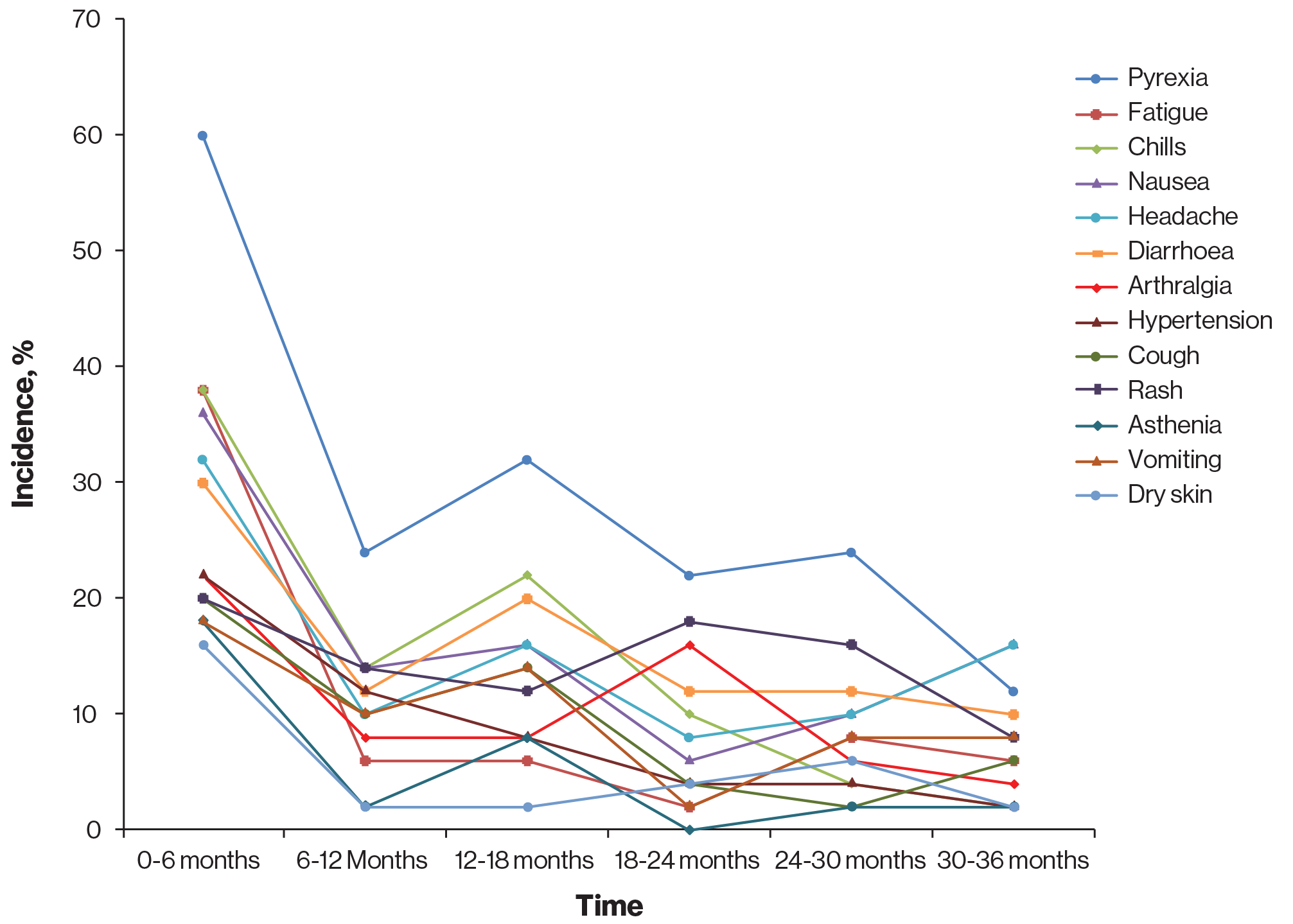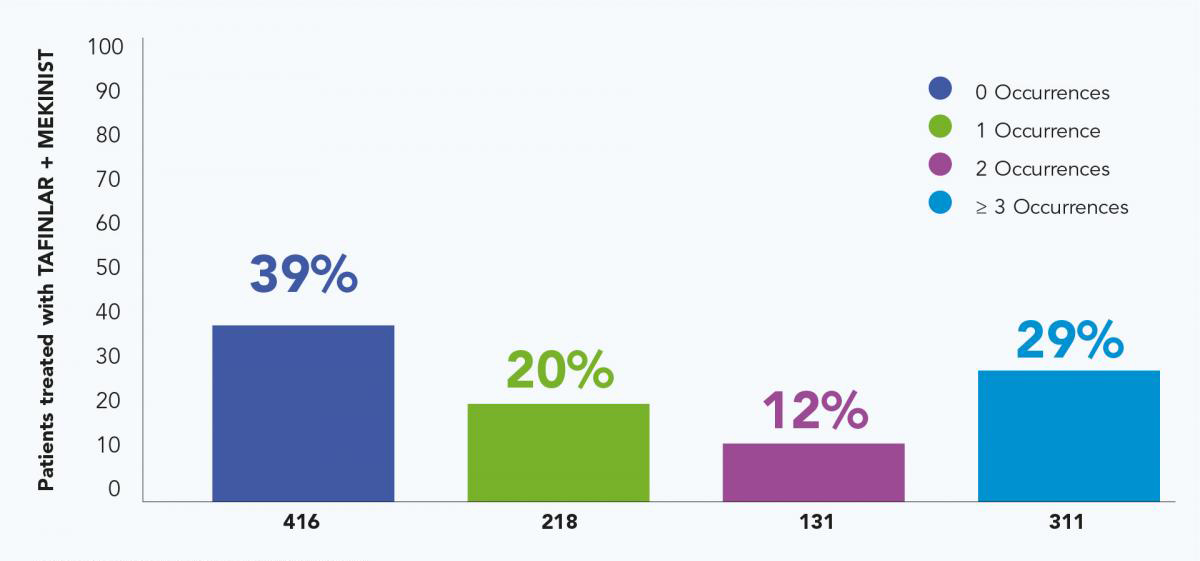

Pooled COMBI-v and COMBI-d safety data
TAFINLAR® (dabrafenib) in combination with MEKINIST® (trametinib) is indicated in adult patients with unresectable or metastatic melanoma with a BRAF V600 mutation.1,2
TAFINLAR in combination with MEKINIST is indicated for the adjuvant treatment of adult patients with Stage III melanoma with a BRAF V600 mutation, following complete resection.1,2
Common adverse events include:
TAFINLAR + MEKINIST: The most common adverse reactions (incidence ≥20%) for dabrafenib in combination with trametinib were pyrexia, fatigue, nausea, chills, headache, diarrhoea, vomiting, arthralgia and rash1,2
TAFINLAR: The most common adverse reactions (incidence >15%) reported with dabrafenib were hyperkeratosis, headache, pyrexia, arthralgia, fatigue, nausea, papilloma, alopecia, rash and vomiting1
MEKINIST: The most common adverse reactions (incidence ≥20%) for trametinib were rash, diarrhoea, fatigue, oedema peripheral, nausea and dermatitis acneiform2
For more safety information on TAFINLAR and MEKINIST, click here.
For the full safety profile, please refer to the Summary of Product Characteristics (SmPC) for TAFINLAR and MEKINIST.
Adverse event reporting: Details of how to report adverse events are available at the bottom of the page. Please refer to the respective SmPC for all licensed indications.
Important safety profile information – Pyrexia
Therapy (TAFINLAR when used as monotherapy, and both MEKINIST + TAFINLAR when used in combination) should be interrupted if the patient’s temperature is ≥38°C
In case of recurrence, therapy can also be interrupted at the first symptom of pyrexia
Treatment with antipyretics such as ibuprofen or acetaminophen/paracetamol should be initiated
The use of oral corticosteroids should be considered in instances where antipyretics are insufficient
Patients should be evaluated for signs and symptoms of infection
Therapy can be restarted once the fever resolves
If fever is associated with other severe signs or symptoms, therapy should be restarted at a reduced dose once fever resolves and as clinically appropriate
The safety profile of TAFINLAR + MEKINIST is well established1–3
Key safety profile insights from COMBI-v and COMBI-d trials in metastatic melanoma
No unexpected adverse events (AEs) were reported with extended follow-up.3
The most common AEs observed with TAFINLAR + MEKINIST in the pooled 5-year analysis included: pyrexia, nausea, diarrhoea, fatigue, headache, chills and vomiting.3
Please visit the pooled efficacy page for further information on the landmark 5-year pooled analysis.
Adverse event profile at 5 years
TAFINLAR + MEKINIST has a generally well-established AE profile, and there were no unexpected AEs after extended follow-up with TAFINLAR + MEKINIST1–3
In the pooled analysis, AEs led to permanent discontinuation of TAFINLAR + MEKINIST in 18% of patients1
No treatment-related deaths were reported in the 5-year pooled analysis3
All-causality AEs occurring in ≥20% of patients treated with TAFINLAR + MEKINIST (5-year pooled analysis)3
| Adverse event, n (%) | COMBI-d | COMBI-v | COMBI-v/COMBI-d | |||
Any grade | Grade ≥3 | Any grade | Grade ≥3 | Any grade | Grade ≥3 | |
Any AE | 203 (97) | 113 (54) | 345 (99) | 218 (62) | 548 (98) | 331 (59) |
Pyrexia | 123 (59) | 16 (8) | 202 (58) | 18 (5) | 325 (58) | 34 (6) |
Nausea | 79 (38) | 1 (<1) | 128 (37) | 2 (1) | 207 (37) | 3 (1) |
Diarrhoea | 68 (33) | 3 (1) | 131 (37) | 5 (1) | 199 (36) | 8 (1) |
Fatigue | 81 (39) | 5 (2) | 117 (33) | 4 (1) | 198 (35) | 9 (2) |
Headache | 71 (34) | 1 (<1) | 122 (35) | 5 (1) | 193 (35) | 6 (1) |
Chills | 68 (33) | 1 (<1) | 122 (35) | 4 (1) | 190 (34) | 5 (1) |
Vomiting | 58 (28) | 2 (1) | 115 (33) | 5 (1) | 173 (31) | 7 (1) |
Arthralgia | 57 (27) | 2 (1) | 104 (30) | 3 (1) | 161 (29) | 5 (1) |
Hypertension | 52 (25) | 12 (6) | 109 (31) | 55 (16) | 161 (29) | 67 (12) |
Rash | 62 (30) | 0 | 96 (27) | 5 (1) | 158 (28) | 5 (1) |
Cough | 51 (24) | 0 | 87 (25) | 0 | 138 (25) | 0 |
Peripheral oedema | 47 (22) | 2 (1) | 61 (17) | 2 (1) | 108 (19) | 4 (1) |
Myalgia | 27 (13) | 1 (<1) | 76 (22) | 0 | 103 (18) | 1 (<1) |
Adapted from Robert C, et al. 2019.3
Pyrexia was the most common AE associated with TAFINLAR + MEKINIST treatment in the adjuvant setting of patients with Stage III . The majority of pyrexia events were Grade 1 or 2.4
TAFINLAR/MEKINIST when used as monotherapy, and both TAFINLAR and MEKINIST when used in combination, should be interrupted if the patient's temperature is ≥38°C. In case of recurrence, therapy can also be interrupted at the first symptom of pyrexia. Treatment with antipyretics such as ibuprofen or acetaminophen/paracetamol should be initiated. The use of oral corticosteroids should be considered in those instances in which antipyretics are insufficient. Patients should be evaluated for signs and symptoms of infection. Therapy can be restarted once the fever resolves. If fever is associated with other severe signs or symptoms, therapy should be restarted at a reduced dose once fever resolves and as clinically appropriate.1,2
Adverse event profile over time
Incidence of AEs was observed to decrease over a 3-year period in patients who received TAFINLAR + MEKINIST5
In a separate pooled analysis of the 3-year data from the COMBI-v and COMBI-d trials, the incidence of AEs was highest at 6 months, and was observed to decrease over time in patients completing at least 36 months of treatment (n=50)5
The incidence of pyrexia more than halved from 60% at 0–6 months to 12% at 30–36 months of treatment5
Incidence of AEs (≥15% for 0–6 months) over time in patients treated with TAFINLAR + MEKINIST for ≥36 months (pooled analysis at 3 years)5

Adapted from Grob GG, et al. 2016.5
A pooled analysis of pyrexia from patients treated with TAFINLAR + MEKINIST
Across four TAFINLAR + MEKINIST clinical trials (n=1076), 39% of patients treated with TAFINLAR + MEKINIST did not experience a pyrexia event, while 32% of patients experienced only one or two events6,7
The majority of pyrexia events were mild or moderate (Grade 1/2). Only 9% of patients treated with TAFINLAR + MEKINIST experienced Grade 3 events and <1% of patients experienced Grade 4 events6,7
Most pyrexia events were completely resolved with either temporary dose interruption or no dose change6,7
Only 6% of patients discontinued treatment with TAFINLAR or MEKINIST due to pyrexia6,7
Pooled analysis of pyrexia: Single vs multiple occurrences*5
The data are based on a pooled analysis of pyrexia occurrence across four clinical trials* representing the largest analysis of a BRAF inhibitor + MEK inhibitor-induced pyrexia to date.6,7

Adapted from Robert C, et al. 2019.6
*Pyrexia was analysed from the following clinical trials in melanoma and in metastatic non-small cell lung cancer (NSCLC): Registrational Phase II trial (NCT01336634) in metastatic NSCLC (n=82); COMBI-AD in resected Stage III melanoma (n=435); COMBI-d in unresectable or metastatic melanoma (n=209); COMBI-v in unresectable or metastatic melanoma (n=350).3,6–8
Please visit the management of patients with BRAF V600-positive melanoma page for further information on monitoring for, and managing, pyrexia in patients receiving TAFINLAR + MEKINIST.
AE, adverse event; BRAF V600, mutation of the BRAF gene at valine (V) 600; NSCLC, non-small cell lung cancer; SmPC, summary of product characteristics.
References
TAFINLAR (dabrafenib) Summary of Product Characteristics.
MEKINIST (trametinib) Summary of Product Characteristics.
Robert C, et al. N Engl J Med 2019;381:626–636.
Long GV, et al. N Engl J Med 2017;377:1813–1823.
Grob JJ, et al. Presented at SMR 2016; 6–9 November, Boston, MA, USA.
Robert C, et al. Presented at ESMO 2019; 27 September – 1 October, Barcelona, Spain.
Schadendorf D, et al. Eur J Cancer 2021;153:234–241.
Planchard D, et al. J Thorac Oncol 2022;17:103–115.
UK | April 2025 | FA-11218913
Adverse events should be reported. Reporting forms and information can be found at www.mhra.gov.uk/yellowcard. Adverse events should also be reported to Novartis online through the pharmacovigilance intake (PVI) tool at www.novartis.com/report, or alternatively email [email protected] or call 01276 698370.